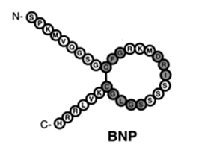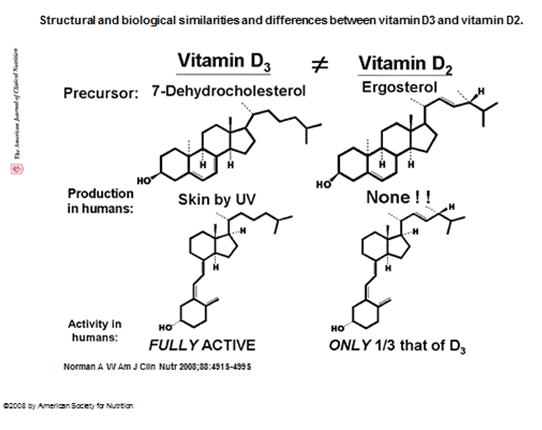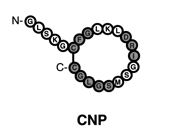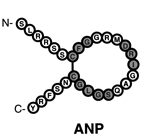Did you know that ticks have antifreeze proteins? A recent study conducted by a Yale professor of medicine focused on ticks and their unique cold resistant properties. These antifreeze proteins are called IAFGP (Ixodes scapularis anti-freeze glycoprotein) and are activated in ticks in the winter and prevent their cells and tissues from freezing. In fact, researchers have discovered that these proteins help to decrease the damage during frostbite, thus reducing or limiting the inflammatory cascade associated with cell death. Mice that were utilized for this study demonstrated a clear resistance to exposure to extreme cold when specially bred with genes to produce IAFGP. There is certainly an enormous amount of potential for such proteins in terms of numerous therapeutic applications. Read More
Category: Default blog


What
is CNP?
CNP stands for C-type natriuretic peptide and it is
derived from a preprohormone of 126 amino acids and a prohormone of 53 amino
acids. CNP was originally found in the
central nervous system in much greater concentrations than ANP or BNP. CNP
is produced by cardiac tissue, but is expressed primarily in the brain,
pituitary gland, vascular endothelium, kidney and female reproductive tract. It
has been discovered that it is produced in the vascular endothelial cells and after
secretion of CNP from these endothelial cells, it is regulated by cytokines and
growth factors.
Unlike ANP and BNP, CNP has a very insignificant role
in natriuretic and diuretic processes. The
physiological role of CNP is not only studied in cardiac disease, but also in
bone developmental biology, bone research, renal diseases, embryonic
developmental research, and vascular diseases. In past studies, it has been
found to play an important paracrine regulatory role in the
vasculature and involvement in neural control.
Biochemical Structure of CNP:
CNP produces 22 and 53 amino acid fragments.
Unlike ANP and BNP, CNP terminates in the second cysteine residue, lacking a
further C-terminal extension.
What is NTproCNP?
NT-proCNP is the amino-terminal peptide derived from the cleavage of the prohormone proCNP. It is an equimolar product of CNP biosynthesis and is easily measured in plasma. NTproCNP is not subject to clearance pathways and it is found in the circulation at 20- to 50-fold higher concentrations than the biologically active forms of CNP.
Why Measure NTproCNP?
NTproCNP is considered to be a reliable and stable marker for measuring
CNP biosysthesis. Studies have revealed
that there is a high serum CNP concentration in critically ill subjects or individuals
who have undergone trauma. NT-proCNP has
been correlated to biomarkers of organ dysfunction and has been associated with
inflammatory and metabolic pathways.
Therefore, it has been recently been proposed as a novel biomarker for
predicting sepsis in traumatized patients.
Indications for CNP:
- Vascular Disease
- Diabetes
- Skeletal Development
- Sepsis
- Renal Disease
References:
- Clerico A et al. “Thirty years of the heart as an endocrine organ: physiological role and clinical utility of cardiac natriuretic hormones.” Am J Physiol Heart Circ Physiol 2011; 301: H12-H20.
- Hoffman et al. “Prognostic Value of Plasma N-Terminal Pro-Brain Natriuretic Peptide in Patients With Severe Sepsis.” Circulation; 2005:112:527-534.
- Koch, A. et al. “Prognostic value of circulating amino-terminal pro-C-type natriuretic peptide in critically ill patients.” Critical Care 2011, 15:R45 doi:10.1186/cc10007.
- Moro, Cedric et al. “Natriuretic Peptides: New Players in Energy Homeostasis.” Diabetes 2009; 12: 2726-2728
- Nazario, B et al. “Atrial and Brain Natriuretic Peptides Stimulate the Production and Secretion of C-type Natriuretic Peptide from Bovine Aortic Endothelial Cells.” Journal of Clinical Investigation 1995 Mar; 95(3): 1151–1157.
- Olney, Robert et al. “Amino-terminal propeptide of C-type natriuretic peptide (NTproCNP) predicts height velocity in healthy children.” Clin Endocrinol (Oxf). 2012 Sep; 77(3): 416–422.
- Schreibe, Donald et al. “Natriuretic Peptides in Congestive Heart Failure.” Medscape 2012: Jan 10.
- Suzuki, T et al. “The Role of the Natriuretic Peptides in the Cardiovascular System.” Cardiovascular Research 2001; 51: 489–494.
Related Resources Citing EagleBio Kits:
Related Kits:
NT-proCNP ELISA Assay Kit
proANP ELISA Assay Kit
BNP Fragment (Nt-proBNP 8-29) ELISA Assay Kit
Cardiovascular Assay Kits
Related News:
EagleBio Spotlight: Natriuretic Peptides
EagleBio Spotlight: ANP
EagleBio Spotlight: BNP
Interesting Study Highlighting Eagle Biosciences’ BNP Fragment ELISA Assay Kit


What
is ANP?
The first
natriuretic peptide was identified in 1983 and named atrial natriuretic peptide
(ANP). ANP is a 28-amino acid polypeptide resulting from the C-terminal end of
the prohormone proANP. It is largely produced in the cardiac atria, and ANP is
quickly secreted in response to atrial stretching. ANP has the following
physiological effects:
- Increases glomerular
filtration rate by dilating afferent arterioles - Inhibits the collecting ducts from reabsorbing sodium,
both directly and indirectly (by inhibiting aldosterone secretion) - Inhibits release of renin
The renin-angiotensin system and ANP
function antagonistically in the maintenance of fluid/electrolyte balance and
blood pressure.
Normal hearts
secrete extremely small amounts of ANP, but elevated levels are found in
patients with left ventricular (LV) hypertrophy and mitral valve disease.
Biochemical structure of ANP:
ANP is synthesized as a 126 amino acidprecursor protein which is cleaved to produce a
96 aminoacid amino-terminal fragment and a 28 amino acid
carboxyl-terminal fragment. The carboxyl-terminal 28 amino acid fragment is the biologically active peptide and
has shorter half-life than the amino-terminal fragment.
Conserved residues are shaded and the line
within the ring represents the disulfide bond.
What
is proANP?
ProANP is the prohormone of ANP (ANP is stored as a
126–amino acid prohormone (proANP1–126)). After this prohormone is released it is then cleaved into equimolar amounts of the biologically active C-terminal peptide (ANP (99–126)) and the residual N-terminal peptide (NT-proANP (1–98)) in response to atrial wall stretch.
α-ANP has a half-life of 3-4 minutes thus is quickly cleared from circulation. ProANP (1-98) on the other hand, has a significantly longer half-life of 60-120 minutes leading to much higher concentrations in blood as compared to α-ANP.
Why Measure proANP (1-98)?
Atrial natriuretic peptide (ANP) has an important physiological roles in fluid homeostasis and cardiac pathology. The longer half life of proANP (1-98) offers advantages for measuring the ANP in the blood over α-ANP due to its lack of sensitivity to the pulsatile secretion of ANP. In fact,proANP (1-98) may provide better insight to the ANP status and its chronic secretion in the blood. Studies have shown that proANP serves as a
valuable and stable marker for several areas of research ranging from sepsis to
predicting and aiding in risk stratification for heart failure.
Diseases/conditions associated with increased ANP levels:
- Diabetes and Obesity
- Renal Disease/Renal dysfunction
- Hypertension
- Pneumonia
- Asthma attacks
- Recent heart attack
- Heart failure/Cardiac impairment
- Cardiomyopathy
- Sepsis
- Sleep apnea
References:
- Haviv, M. et al. “Atrial Natriuretic Peptidein Children with Pneumonia.” Pediatric Pulmonology 40:306–309(2005).
- Hoffman et al. “Prognostic Value of Plasma N-Terminal Pro-Brain Natriuretic Peptide in Patients With Severe Sepsis.” Circulation; 2005:112:527-534.
- Lauridsen, Bo K et al. “ProANP Plasma Measurement Predicts All-Cause Mortality in Acutely Hospitalized Patients: A Cohort Study.” BMJ Open 2013;3:e003288 doi:10.1136/bmjopen-2013-003288.
- Moro, Cedric et al. “Natriuretic Peptides: New Players in Energy Homeostasis.” Diabetes 2009; 12: 2726-2728.
- Robichaud, A. et al. “Plasma Atrial Natriuretic Peptide During Spontaneous Bronchoconstriction in Asthmatics. Peptides 1995;16(4):653-6.
- Suzuki, T et al. “The Role of the Natriuretic Peptides in the Cardiovascular System.” Cardiovascular Research 2001; 51: 489–494.
Related Resources Citing EagleBio Kits:
Related Kits:
proANP ELISA Assay Kit
Cardiovascular Assay Kits
Related News:
EagleBio Spotlight: Natriuretic Peptides
EagleBio Spotlight: BNP
EagleBio Spotlight: CNP
Interesting Study Highlighting Eagle Biosciences’ BNP Fragment ELISA Assay Kit


EagleBio’s quarterly newsletter is due out soon! Don’t forget to subscribe!
Fascinating Research
Exciting Announcements
Chance to Win Great Prizes
Visit eaglebio.com & SUBSCRIBE AT THE BOTTOM OF PAGE

A recent study just published in February of 2015 in the Hong-Kong Medical Journal discusses a medical case of a baby girl, born at Queen Elizabeth Hospital in Hong Kong in 2010. Doctors and other medical staff originally believed that the masses seen in prenatal ultrasounds were two tumors. It wasn’t until the baby was born that they discovered that the masses were two fetuses that gestated up to 10 weeks. Read More
image above from www.people.com



What
is BNP?
BNP stands for Brain natriuretic peptide or otherwise
known as B-type natriuretic peptide (BNP) and is produced from a preprohormone
precursor. BNP was named after it was originally identified in extracts of
porcine brain, hence brain natriuretic peptide.
Even though in humans, this peptide is produced mainly in the cardiac
ventricles its name remains the same. Following cardiac hemodynamic stress,
both atrial natriutetic peptide (ANP) and BNP are secreted from the heart (primarily produced by atrial and
ventricular cardiomyocytes). BNP is mainly expressed by ventricular myocardium
in response to volume overload and increased filling pressure. BNP
may be only activated after a prolonged period of volume overload and thus
acting like a backup hormone in response to heart stress.
The release of BNP into the blood stream causes
dilation of the blood vessels, and thereby dilation of the arteries. This begins the process of the body’s natural
response to reduce blood pressure in the body, followed by blockage of adrenalin,
and finally the release of sodium and water into the urine (natriuresis). Healthy individuals typically exhibit the
highest BNP concentrations in the atria but BNP is shifted to the ventricles in
heart failure (HF). A high concentration of BNP in the bloodstream is
indicative of heart failure. In fact, BNP
is predictive of cardiac dysfunction, in particular left ventricular
dysfunction, and is a useful marker of future outcomes in patients with acute
coronary syndromes and congestive heart failure.
Biochemical structure of BNP:
BNP is produced as a 108 amino acid precursor protein
which is cleaved into a biologically active 32 amino acid carboxyl-terminal
fragment and a 76 amino acid amino- terminal fragment.

Conserved residues are shaded and the line
within the ring represents the disulfide bond.
The N-terminal peptide comprising amino acids 1-76 is further degraded proteolytically and thus BNP fragments in the circulation are very heterogeneous. There are a few different circulating forms of BNP such as BNP-32 (77-108), a high molecular weight BNP and and the NT-proBNP (1-76).
The BNP fragment (Nt-proBNP 8-29) is the preferred analyte for representation of BNP status for a few reasons. BNP Fragment is a stable molecule, has a long half-life and it circulates in high concentrations.
Why Measure BNP?
BNP has a key role in cardiovascular homeostasis with biological actions including natriuresis, diuresis, vasorelaxation, and inhibition of renin and aldosterone secretion. Because of its broad range of functions in the body, measuring this analyte can be used for studying and/or monitoring the diseases/conditions below.
Diseases/conditions associated with elevated BNP levels:
- Diabetes and
Obesity - Renal Disease/Renal
dysfunction - Hypertension
- Pneumonia
- Asthma
attacks - Recent
heart attack - Heart
failure/Cardiac impairment - Cardiomyopathy
- Sepsis
- Sleep
apnea
References
- Clerico A et al. “Thirty years of the heart as an endocrine organ: physiological role and clinical utility of cardiac natriuretic hormones.” Am J Physiol Heart Circ Physiol 2011; 301: H12-H20.
- Davis, William et al. “A Special Test to Diagnose Heart Failure.” Life Extension Magazine; 2007: Jun.
- Doust, Jenny et al. “The Role of BNP Testing in Heart Failure.” American Family Phyisician; 2006 Dec 1;74(11):1893-190.
- Mair, Johannes. “What are the differences between NT-proBNP and BNP, and do they matter?” Cardiac Biomarkers; 2011: Dec 1;74(11):1893-1900.
- Moro, Cedric et al. “Natriuretic Peptides: New Players in Energy Homeostasis.” Diabetes 2009; 12: 2726-2728.
- Suzuki, T et al. “The Role of the Natriuretic Peptides in the Cardiovascular System.” Cardiovascular Research 2001; 51: 489–494
Related Resources Citing EagleBio Kits:
Related Kits:
BNP Fragment (Nt-proBNP 8-29) ELISA Assay Kit
Related News:
EagleBio Spotlight: Natriuretic Peptides
Interesting Study Highlighting Eagle Biosciences’ BNP Fragment ELISA Assay Kit


EagleBio is pleased to share a list below of publications referencing use of our Shikari Kits from Matriks Biotek. Our Shikari Kits are esoteric assays and are not only the gold standard of anti-drug antibody kits world worldwide but are also incredibly user friendly.
Click the links below for further details.
Publications:
Kato S, et al, Elevated Serum IgE Prior to Acute Severe Infusion Reaction During Infliximab Maintenance Therapy in a Crohn’s Disease Patient, Crohn’s & Colitis Foundation of America (2011)
Related News:
Matriks Introduces Eagle Biosciences, Inc. As Distributor in North America
New Publication Presented at UEG For Therapeutic Drug Monitoring Using EagleBio’s SHIKARI® ELISA Kits from Matriks
Related Kits:
Shikari ELISA Assay Kits


What is Endostatin?
Angiogenesis is the formation of new capillaries from preexisting blood vessels. Endostatin is a 20-kDa C-terminal fragment of collagen XVIII that plays a key role as an angiogenesis inhibitor and consists of 183-184 amino acid residues (its molecular weight is 20 kD). As a potent inhibitor of angiogenesis, endostatin has been found in recent studies to activate a series of signaling pathways thereby inducing endothelial cell apoptosis. It binds to numerous membrane proteins including integrins and heparin sulfate and this binding is further evidence of this biomarker’s involvement with multiple signaling pathways in regards to angiogenesis. In addition, other functions of endostatin in relation to cell death processes include roles in reducing cell migration, adhesion, and proliferation.
Endostatin is generated by proteoltyic cleavage by proteases or matrix metalloproteinases (MMPs) (MMPs have a variety of actions influencing fibrinolysis and angiogenesis). It is localized in the vascular basement membrane zones in various organs. Following the proteolysis, once endostatin is formed it can either stay attached to basement membranes (immobilized) or be released into circulation (soluble). Research has demonstrated that both forms of endostatin have unique biological activities. These activities at the molecular level are still being studied but thus far, it has been discovered that endostatin in combination with angiogenic factors, have an integral role in endothelial response to tissue damage such as renal injury.
Reasons to Measure Endostatin
Endostatin is a vital component for angiogenesis which is necessary for numerous pathological functions, therefore it has been indicated in a vast variety of diseases and other medical conditions. Measuring endostatin can provide remarkable value for detecting and monitoring diseases/conditions, predicting disease risk, and offering a new target for multiple therapies in related areas of research.
Endostatin has been associated with many diseases such as:
- Chronic Kidney Disease (CKD)
- Renal Microvascular Disease
- Atherosclerosis
- Idiopathic Pulmonary Fibrosis (IPF)
- Cancer
References:
- Bellini MH et al. “Immobilized Kidney 28-kDa Endostatin-Related (KES28kDa) Fragment Promotes Endothelial Cell Survival.” Bellini MH et al., Am J Nephrol, 2010; 31(3):255-61.
- Chen J et al. Elevated Plasma Levels of Endostatin are Associated with Chronic Kidney Disease”. Am J Nephrol, 2012; 35(4): 335-40.
- Faye, Clement et al. “The First Draft of the Endostatin Interaction Network.”The Journal of Biological Chemistry 2009; 284, 22041-22047.
- Iqbal CW et al. “Early-onset Coronary Artery Disease After Pediatric Kidney Transplantation: Implicating the Angiogenesis Inhibitor, Endostatin.”. Am Surg, 2011; 77(6): 731-5.
- Nyberg, Pia et al. “Endogenous Inhibitors of Angiogenesis.” Cancer Res 2005; 65: (10).
- Rehn, Marko et al. “Interaction of Endostatin with Integrins Implicated in Angiogenesis.” PNAS, 2001; 98: 1024–1029, 2001.
- Richter et al. “Soluble Endostatin is a Novel Inhibitor of Epithelial Repair in Idiopathic Pulmonary Fibrosis.” Thorax 2009;64:156–161.
- Sodha NR et al. “Endostatin and angiostatin are increased in diabetic patients with coronary artery disease and associated with impaired coronary collateral formation.” Am J Physiol Heart Circ Physiol, 2009; 296: H428 – H434.
Related Kits:
February 2015- Eagle Biosciences, Inc. is pleased to introduce a new Multispecies ELISA Assay kit. This assay was developed at IBT (Immunological and Biochemical
Testsystems GmbH) in Germany. IBT’s core business surrounds the production of
high quality products in the field of Endocrinology and other related areas of
research.
This kit is designed for the simple and very
sensitive determination of Insulin-like Growth Factor 1 (IGF-1). IGF-1 is also
known as somatomedin C, and is a polypeptide of 70 amino acids and is a growth factor
for a wide range of cell types. IGF-1 is associated with cancer, neuropathy,
stroke, growth/development, aging, malnutrition/malabsorption, hypothyroidism, obesity, liver
disease, kidney disease, diabetes mellitus complications, and chronic
inflammatory disease.
“This
ELISA kit has excellent specificity for multiple species such as human, porcine, bovine and guinea pig with results in under 4 hours.”
said Dan Keefe, President of Eagle. He continued, “This product certainly
offers a lot in terms of versatility and is an exceptional addition to our
Endocrine Assay Kit line.”
These
products are currently for research use only. Check out the links below, visit
the Eagle website, www.EagleBio.com, or call 866-411-8023 for full details.
Multispecies IGF-1 ELISA
Endocrine Assay Kits


Vitamin D is
a steroid hormone made up of a group of fat-soluble secosteroids responsible
for enhancing intestinal absorption of calcium, iron, phosphate, magnesium, and
zinc and involved in the regulation of homeostasis. Vitamin D exists in two
forms, specifically ergocalciferol (vitamin D2), and cholecalciferol (vitamin
D3).
Vitamin
D3 is formed in the skin after exposure to sunlight or ultraviolet light, and vitamin
D2 is acquired by irradiation of plants or plant materials or foods. Both D2
and D3 forms are not yet biologically active
and are bound by a protein called VDBP (vitamin D binding protein)
in the bloodstream. Subsequently, the bound form is metabolized in the liver
where a conversion occurs into storage forms (with limited biological activity)
of the vitamin: 25-OH vitamin D2 (calcidiol) and 25-OH vitamin D3 (calcitriol).
This metabolite has been found to be the predominant circulating from of
Vitamin D and had been recognized as an accurate indicator of an individual’s
vitamin D status.

Figure 1:
D2 and D3 Structures (Norman, A. et. al)
Reasons to Measure Vitamin D
Vitamin
D is not only important for bone health but can also play a role in the
development of several non-bone related diseases. There has much debate over the past 6 decades
with regards to of which form of vitamin D to measure and which best reflects
vitamin D status. Since both D2 and D3
are used for therapy, it is necessary to measure both circulating forms. The
only way to assess a person’s vitamin D status (vitamin D deficient, sufficient,
or intoxicated) is to measure their circulating level of 25-OH Vitamin D.
Vitamin
D deficiency has been associated with many diseases such as:
- Rickets
- Osteomalacia
- Osteoporosis
- Hyperparathyroidism
- Multiple
Sclerosis - Cancers
- Cardiovascular
diseases - Depression
References:
2. Lips P. Vitamin D physiology. Prog Biophys Mol Biol 2006; 92: 4-8.
9. Snellman, G. et al. “Determining Vitamin D Status: A Comparison between Commercially Available Assays.” PLoS One 2010; 13:5(7):e11555.
Related Kits:
Vitamin Assay Kits
Bone Metabolism Assay Kits
Related News:
Vitamin D Publications
10 Reasons to Keep Up with Your Vitamin D Levels




